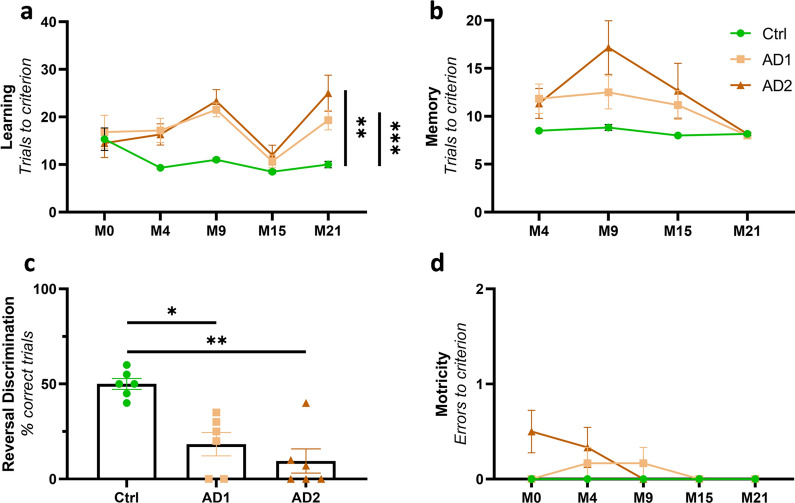Fig. 11.
Cognitive impairment induced by AD brain inoculations. a Longitudinal evaluation revealed learning deficits in AD groups compared to the Ctrl group (Time effect: F(2.18, 32.73) = 8.42, p = 0.0009; Group effect: F(2, 15) = 9.52, p = 0.002; p = 0.0002 and 0.004, respectively for AD1 and AD2 compared to the Ctrl group; two-way ANOVA with the Geisser-Greenhouse correction, Tukey’s multiple comparisons). b Memory performance comparison revealed a group effect throughout the follow-up, but no statistical difference between AD1, AD2 and Ctrl animals was detected following post-hoc evaluations (Time effect: F(2.46, 6.95) = 7.40, p = 0.001; Group effect: F(2, 15) = 3.83, p = 0.045; p = 0.066 between AD2 and Ctrl at 9 mpi, p > 0.17 for every other comparisons; two-way ANOVA with the Geisser-Greenhouse correction, Tukey’s multiple comparisons). c Reversal learning task performed at 21 mpi revealed deficits in AD groups compared with the Ctrl group (p = 0.024 and 0.0045, respectively for AD1 and AD2; Kruskal–Wallis with Dunn’s multiple comparisons). For all of the evaluated cognitive functions, no statistical difference was observed between AD1- and AD2-inoculated lemurs. d No motor impairment was observed with age and between the groups all throughout the follow-up (Time effect: F(2.16, 32.42) = 2.35, p = 0.11; Group effect: F(2, 15) = 2.57, p = 0.11; two-way ANOVA with the Geisser-Greenhouse correction, Tukey’s multiple comparisons). *p < 0.05; **p < 0.01; ***p < 0.001. Data are shown as mean ± s.e.m

